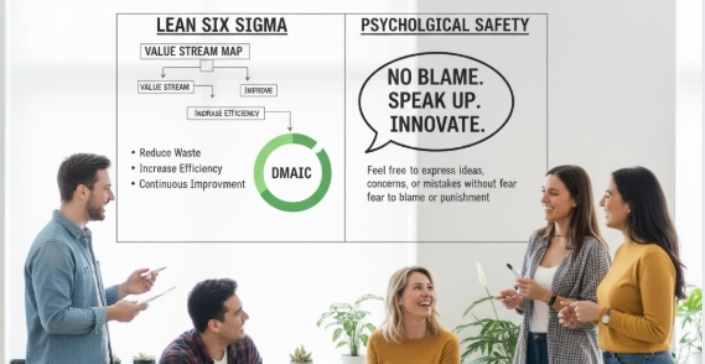Most organizations talk about continuous improvement, but few realize that it doesn’t start with tools, dashboards, or Kaizen events.
It starts with people feeling safe to speak up.
If your team is afraid to share bad news, question a decision, or suggest a better way, no amount of Lean training will fix that.
Because psychological safety is the foundation of every successful improvement culture.
What Is Psychological Safety?
Psychological safety means that people feel free to express ideas, concerns, or mistakes without fear of blame or punishment.
It’s not about being “soft”, it’s about creating an environment where learning and innovation can actually happen.
When people believe their input is valued, they’re more likely to:
- Speak up when something doesn’t work
- Share creative ideas for improvement
- Admit mistakes early (before they become costly problems)
- Collaborate instead of compete
In other words, psychological safety turns silence into progress.
A real example: When management started to “Celebrate Problems”
In one organization I worked with, the management team decided to launch a bold cultural shift: they began to “celebrate problems.”
Instead of hiding inefficiencies or assigning blame, leaders started to openly highlight process problems in their own departments. During team meetings, they would say things like:
“Here’s an issue we discovered in our process. Let’s work together to solve it.”
By doing this, they modelled the behaviour they wanted to see: that identifying a problem doesn’t get you blamed, it gets you helped.
The shift was powerful: fear turned into curiosity, and continuous improvement became everyone’s responsibility.
This example perfectly illustrates that psychological safety begins with leadership vulnerability. When leaders go first, admitting what’s not perfect, they give everyone else permission to do the same.
Why Lean and Six Sigma depend on it
Lean and Six Sigma thrive on honest data and open collaboration. Without that, the entire improvement cycle breaks.
Think about it:
- Can you identify waste if employees are afraid to talk about inefficiencies?
- Can you find root causes if people hide process failures?
- Can you improve flow if nobody challenges “the way we’ve always done it”?
The truth is, continuous improvement fails when fear dominates the culture.
Tools like 5S, Kaizen, or DMAIC only work when people feel safe enough to use them honestly.
Lean principle: Respect for people comes before respect for process.
Leadership: The silent variable in continuous improvement
A culture of safety doesn’t happen by accident: it’s modelled by leadership.
Leaders create (or destroy) psychological safety through everyday behaviour:
- Do you listen when someone challenges your idea?
- Do you thank people for pointing out problems, or subtly punish them?
- Do you involve the team in decisions that affect their work?
Great leaders understand that there’s no single style of leadership that fits every person or every situation. Depending on the maturity, skill level, and confidence of the team, leaders need to flex between guiding, coaching, supporting, and delegating.
When teams are new, be directive and supportive
When a team is just starting a process improvement journey, people often hesitate to speak up or make decisions.
A situational leader provides clear direction while showing visible support.
Example:
A process improvement manager starts every daily huddle by asking,
“What didn’t work well yesterday?”
Then thanks each person who shares a problem and follows up to help resolve it.
This early structure teaches the team that it’s safe to be honest and that leadership is there to help, not judge.
When confidence grows, shift to coaching
As teams mature, leaders move from directing to coaching guiding problem-solving instead of giving answers.
Example:
Instead of saying, “Fix the delay in approval,” a leader might ask,
“What’s causing this delay, and what ideas do you have to reduce it?”
This approach builds ownership and reinforces that continuous improvement is team-driven, not manager-enforced.
When teams are capable, empower and delegate
High-performing Lean teams thrive when trusted to act independently.
Here, situational leadership means stepping back and letting people take initiative.
Example:
A leader might say,
“If you identify a recurring issue, document it, form a small group, and test a countermeasure. Let’s review results next week.”
This trust transforms the culture from compliance to commitment.
People no longer wait for permission to improve; they feel empowered to own results.
When teams struggle, rebuild safety and reconnect
Even mature teams sometimes lose momentum or confidence.
When that happens, effective leaders re-engage personally, rebuild trust, and remind everyone that failure is part of improvement.
Example:
A senior leader publicly shares a process change that didn’t work and says,
“We tried, it failed and that’s okay. What did we learn?”
Moments like this reaffirm safety and model resilience, reinforcing that the Lean journey is about learning, not perfection.
How to Build Psychological Safety in Your Team
Here are five practical ways to start:
- Ask for input first. Before giving your opinion, ask your team how they would approach the problem.
- Normalize mistakes. Use errors as learning moments, not blame sessions.
- Reward openness. Publicly recognize those who raise issues or challenge assumptions.
- Follow up visibly. When someone shares feedback, act on it.
- Be vulnerable. Admit when you don’t know or made a mistake. It gives others permission to do the same.
These small actions create the trust needed for continuous improvement to flourish.
The Bottom Line
Continuous improvement starts with psychological safety because people drive processes.
Without trust, process improvement becomes mechanical. With it, it becomes transformational.
So before you introduce another method or metric, take a step back and ask:
“Does my team feel safe to improve?”
For more on this idea, see Amy Edmondson’s work on psychological safety





